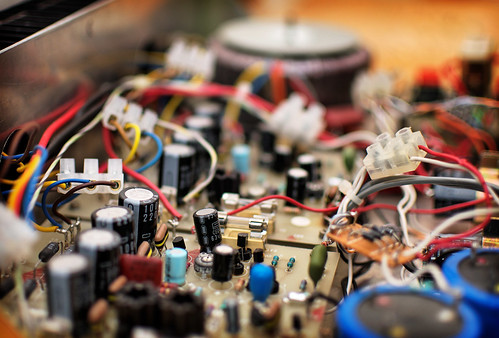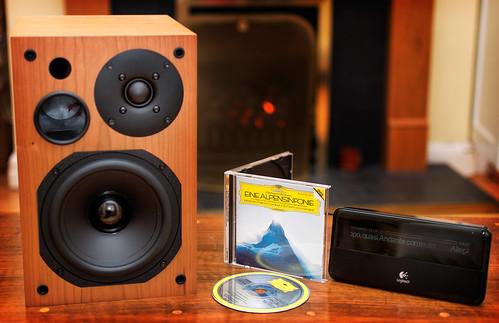The Dark Ages
My first awareness of Hi-Fi came from glossy advertisements in the Sunday supplements. The age of the “music centre” had (just) passed and the in-vogue technology was of the “tower” – preferably that lit up like a Jodrell Bank control console, and which contained a record deck, cassette tape player, amp, tuner and the inevitable “graphic equalizer” – all preferably encased in a cabinet with a smoked glass front. I particularly remember the Philips “Black Tulip” system as seeming particularly desirable.
Gaslight
Soon, like any self-respecting teenage geek, I learned that in fact in the realm of true Hi-Fi one had separates: a record player, an amp, and speakers. Graphic equalizers were frowned upon, and even tone controls were seen as a bit iffy. Received wisdom was that the most important thing was the source (the record player) – on the not-unreasonable premise that if what was being extracted from the vinyl was no good, it could not be rescued downstream.
So began my quest for decent sound, ending (largely through purloining things from my father’s system) with a Garrard 401 turntable (which type – amazingly – still seems to command good money on eBay), and SME Series V tonearm (which – even more amazingly – is still available in a newer incarnation starting from £2,050) together with some fiddly moving coil cartridge. Everything sounded okay in its own terms but the trouble came comparing this “Hi-Fi” to live music. I’d go to London and listen to Klaus Tennstedt conduct the London Philharmonic Orchestra in a Mahler symphony, then come home and listen to the same forces perform the same work on record; there was no comparison. Nor was the problem limited to this setup, every other “audiophile” setup I heard exhibited the same kind of problems, which were (as Ken Rockwell recently wrote in typically forthright fashion) essentially caused by LPs:
LPs are awful. Audiophiles are often hoping that I'm endorsing LPs, but no. These "plastic dog plops," as one mastering engineer referred to them, are loaded with noise, wow & flutter, distortion, echoes, room feedback and even pitch changes from never being pressed on-center. LPs usually have their lows cut, or at least summed to mono. Some people prefer the added noise and distortion, much as a veil hides the defects in an ugly woman's face, allowing our brain to fill-in what we want to see.
Perfect Sound Forever?
Soon after CD was launched commercially as audio format, it became clear which way things were heading and so in 1984 I happily sold off my LP collection and purchased a Philips CD100 top-loading CD player. It was odd recently to take my son to the Science Museum and see one of these units as part of a “how we used to live” exhibit!
This CD player, with its signal routed (via potentiometer) into a home-made power amplifier (J Linsday Hood design like this) and feeding a pair of cheap-but-good KEF Coda III speakers clearly offered a step change to anything I’d heard from LP-based systems, although amazingly some people claimed at the time – and still claim – LP could complete with digital sound; either they had something very wrong with their systems or else never listened to live music!
This kind of combination (with occasional modest improvements from upgrading the player or the speakers) was my “Hi-Fi” for the next 25 years – although one significant improvement came in year 21 from the addition of a subwoofer (in this case an MJ Acoustics Pro 50 Mk II). It takes a while to get the levels set right, but a properly integrated sub-woofer not only fills in the all important bottom octaves, but seems to make the whole sound (for example in orchestral music) more realistically airy.

Inside a home-brew power amp
But how “hi” was the “fi” of this system? Although pretty good it always seemed there were a few things not quite right…
- Character: I tend to classify loudspeakers as “happy” or “sad” – and the distinction sometimes only becomes apparent after long acquaintance. In general I prefer (happy) speakers with good presence and a tendency to warmness – speakers with a recessed middle ultimately give less pleasure even if their “sparkling” treble and/or deep bass may have sounded good at first.
- Volume handling: as speakers get louder (at an orchestral climax for example) they can have a tendency to sound more and more strained – and savour more of “speakers” than of the music. This is particularly the case with less-powerful transistor-based amplification – which also tends to impart a certain unpleasant hard character to the sound.
- Real bass: real bass (as experienced in the concert hall) is not warm, fuzzy and indistinct, but has a musical and visceral quality far removed from the inchoate whumping noises emitted by low-quality sub-woofers.
- Detail: more is not necessarily good (as sometimes low-fi reproduction can accentuate things a high-fidelity set up won’t), but presentation of different instruments in the overall blend such that one can concentrate on something if one wants to. For stereo recordings, a good strong stereo image helps here as the instrument will be coherently positioned at a location in the sound stage.
Audio File
The problem of too many CDs seemed like a good opportunity for a re-think; if these could all be ripped to a server then streamed, might this also be an opportunity to upgrade the “Hi-Fi” also?
Looking around, it seemed the answer might be yes. In particular, a British firm caught my attention: AVI Hi-Fi and its ADM 9.1 active loudspeakers. AVI’s robust promotional material seemed congenial (its lambasting of cable fetishism is worth a read), and its premises made engineering sense, in particular that:
- The digital source does not matter – a cheapo off-brand CD player will extract the same bits from a CD as the most exotic “transport” (funny how this turns on its head the old wisdom of the source mattering most)
- The DAC does matter, hence the best that money can buy should be used
- Even given a good speaker design, there are advantages to be had from doing away with the need for a passive crossover (as the AVI site has it: “this is fact not hype” !).
The ADM 9.1’s are thus an almost-complete “system” needing only to be fed a signal (preferably bits via their optical input, to take advantage of the high-quality inbuilt DAC). Each unit is a ported two-driver active speaker; each requires mains power; and each contains two amplifiers – 75 watts for the tweeter and 250 watts for the woofer. The master speaker unit accepts line-level input and/or up to two optical inputs via TOSLINK. The connection to the slave unit is via RCA phono cable, and there is an additional line-level output to drive a sub-woofer (I continue to use my MJ Acoustics unit, but AVI also make their own matched sub-woofer for rather more money). The setup is controlled by a simple remote handset which allows for source selection and volume control.
And how do they sound? Well, after a few weeks making sure to eliminate any false first impressions I find them superb. All the traditional problem areas of hi fi reproduction have been addressed, in particular:
- There is no apparent false warmth; the lower midrange and bass are tight and precise (and even better with a sub-woofer). But “lack of warmth” does not imply these are cool speakers, more that they are neutral … if you’ve ever listened to high-end headphones you’ll recognise the free, uncoloured type of sound. I’ve read some reports these speakers are too clinical. I don’t agree: it’s just fidelity.
- Volume: these babies go loud, and do so without losing the plot. A nice side-effect of this is that even at volumes approaching “realistic levels” they are not unduly fatiguing (I mean “realistic levels” for classical music!).
- Detail: the stereo image is particularly solid, and maybe this helps the very strong sense of detail – so for example when listening to a Beethoven symphony the subsidiary background motoric rhythms in the strings are “there” if you care to listen to them.
Most surprisingly, I was expecting the ADM’s to be a merciless revealing lens through which to view the problems of early recordings, but – on the contrary – good quality analogue material sounds better than ever – something like Peter Maag’s legendary 1960 recording of Mendelssohn's Scottish Symphony (for example) sounds gorgeous. I wonder what the reason for this is.
Are they perfect? No, not quite – listening to the human voice one is sometimes aware of a slight cabinet-i-ness to the sound. But this is a picky caveat – what I’m hearing now is the closest to real I’ve ever heard from my own or other systems.

An
ADM 9.1 unit with a CD and
Logitech Squeezebox. Karajan's
Eine Alpensinfonie (pictured)
was the first commercial CD pressed; the rather nasty recording quality of this,
and may other early CDs, became associated with digital recording itself and set
the cause of digital audio back among audiophiles.
The end of the CD
To drive the ADM 9.1’s I use a Logitech Squeezebox. The long process of ripping my CD collection is underway but it is increasingly clear music in future is going to come straight off the net. I’ve just bought the “studio master” 24-bit FLACs of a thrilling new set of Mozart symphonies from Sir Charles Mackerras and the Scottish Chamber Orchestra. From a server upstairs the bits are sent over a wireless network to the Squeezebox and then down an optical cable straight into the ADM 9.1’s. I’m not sure my ears are able to detect the advantage of 24-bit over 16-bit material, but the end result is absolutely riveting musical reproduction. Maybe this kind of system will form the template for my next 25 years of Hi-Fi life …
[Disclaimer: I have no connection with any of the companies or products mentioned in this posting!]
Update — February 2012
I am still as impressed with these speakers as when I wrote this post originally. I have had a query about how well the MJ Acoustics subwoofer works: again, very well. The one tricky thing is getting it properly integrated with the main speakers. My (not very technical) method for doing this is to use a recording with a very well-recorded bass drum, and then adjust the settings until it sits properly in the orchestral texture. My current disc of choice for this exercise is the excellent recording of Mahler's Symphony No 1 by the Pittsburg Symphony Orchestra conducted by Manfred Honeck. The settings achieved by doing this, at least in my listening room, can be seen in the photograph below.